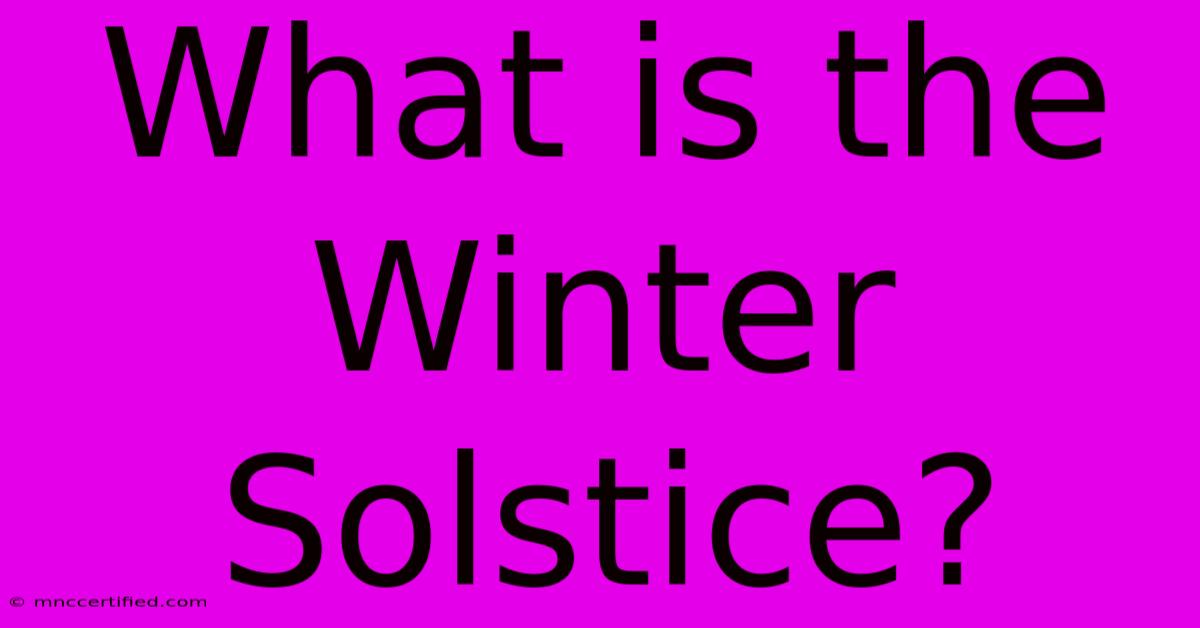What Is The Winter Solstice?

Table of Contents
What is the Winter Solstice? A Deep Dive into the Shortest Day of the Year
The winter solstice, a day marked by both ancient traditions and scientific significance, is a celestial event that captivates the imaginations of many. But what exactly is the winter solstice? This comprehensive guide will explore its astronomical origins, cultural celebrations, and the fascinating phenomena associated with it.
Understanding the Astronomical Mechanics of the Winter Solstice
The winter solstice occurs when the sun reaches its lowest point in the sky, marking the shortest day and longest night of the year in the Northern Hemisphere. This happens because the Earth's axis is tilted at approximately 23.5 degrees relative to its orbital plane around the sun. This tilt means that during part of the year, the Northern Hemisphere is angled away from the sun, resulting in less direct sunlight and shorter days. The opposite is true in the Southern Hemisphere, where the summer solstice occurs during the Northern Hemisphere's winter.
The Significance of the Earth's Tilt
This seemingly simple tilt is the key to understanding the seasons. It's not the Earth's distance from the sun that causes winter, but rather the angle at which the sun's rays strike the Earth's surface. During the winter solstice, the sun's rays strike the Northern Hemisphere at a very oblique angle, resulting in less solar energy and the characteristic cold temperatures.
When Does the Winter Solstice Occur?
The exact date of the winter solstice varies slightly from year to year, typically falling between December 20th and 23rd in the Northern Hemisphere. It's determined by the Earth's position in its orbit around the sun, a journey that takes precisely 365.25 days, hence the need for leap years. You can easily find the precise date for your location using online astronomical calendars or weather websites.
Cultural Celebrations and Traditions Surrounding the Winter Solstice
For millennia, cultures around the world have observed the winter solstice with unique ceremonies and festivals. The shortest day often symbolized rebirth, hope, and the promise of longer days to come.
Ancient Traditions:
- Stonehenge (England): This prehistoric monument is famously aligned with the winter solstice sunrise, a testament to the astronomical knowledge of ancient peoples.
- Yule (Norse and Germanic Cultures): This midwinter festival celebrated the return of the sun and often involved feasting, bonfires, and the burning of Yule logs.
- Saturnalia (Roman Empire): A week-long festival dedicated to Saturn, the god of agriculture, marked by revelry, gift-giving, and a temporary reversal of social norms.
- Dongzhi Festival (China): This crucial festival emphasizes family unity and eating tangyuan, sweet rice balls symbolizing togetherness and wholeness.
Modern Celebrations:
While many ancient traditions have evolved, the winter solstice continues to be a time for reflection, celebration, and community gatherings. Many people use this time for introspection, setting intentions for the coming year, or simply enjoying the cozy atmosphere of the longest night.
The Winter Solstice and its Impact on Nature
Beyond cultural significance, the winter solstice profoundly impacts the natural world. The decrease in daylight hours triggers changes in plant life, animal migration patterns, and even human physiology. The shorter days influence the hibernation cycles of animals and the dormancy of plants, preparing them for the harsher conditions of winter.
Beyond the Basics: Exploring Related Phenomena
- Subsolar Point: The subsolar point, the point where the sun is directly overhead, reaches its southernmost latitude at the winter solstice.
- Equinoxes: Understanding the winter solstice helps grasp the contrast with the equinoxes, where day and night are roughly equal in length.
- Winter Solstice Sunrise/Sunset: The precise timing and position of the winter solstice sunrise and sunset are often fascinating to observe and photograph.
By understanding the astronomical causes and the rich tapestry of cultural celebrations associated with the winter solstice, we gain a deeper appreciation for this significant celestial event and its enduring influence on humanity and the natural world. It’s a time to reflect, celebrate, and look forward to the gradual return of the sun and the promise of spring.

Thank you for visiting our website wich cover about What Is The Winter Solstice?. We hope the information provided has been useful to you. Feel free to contact us if you have any questions or need further assistance. See you next time and dont miss to bookmark.
Featured Posts
-
Crypto Slump Xrp Eth Sol Down
Dec 21, 2024
-
Microneedle Devices Pharmas Future
Dec 21, 2024
-
Germany Car Crashes Into Crowd In Magdeburg
Dec 21, 2024
-
Bitcoin Market Affected By Rates
Dec 21, 2024
-
Biden Announces 4 28 B Student Loan Relief
Dec 21, 2024